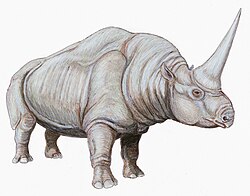| Hipparion Temporal range: Late Miocene | |
|---|---|
 | |
| Skeleton on display at the National Natural History Museum of China | |
| Scientific classification | |
| Kingdom: | Animalia |
| Phylum: | Chordata |
| Class: | Mammalia |
| Order: | Perissodactyla |
| Family: | Equidae |
| Subfamily: | Equinae |
| Tribe: | † Hipparionini |
| Genus: | † Hipparion De Christol, 1832 |
| Species | |
See text | |
| Synonyms | |
| |
Hipparion is an extinct genus of three-toed, medium-sized equine belonging to the extinct tribe Hipparionini, which lived about 10-5 million years ago. [1] [2] While the genus formerly included most hipparionines, the genus is now more narrowly defined as hipparionines from Eurasia spanning the Late Miocene. [2] Hipparion was a mixed-feeder who ate mostly grass, and lived in the savannah biome. [2] [3] Hipparion evolved from Cormohipparion , [2] and went extinct due to environmental changes like cooling climates and decreasing atmospheric carbon dioxide levels. [4]












